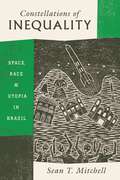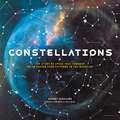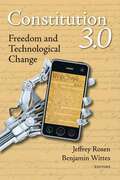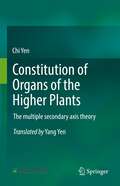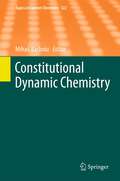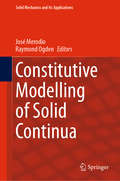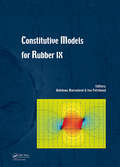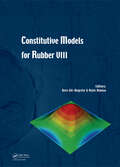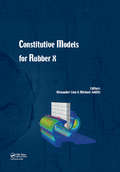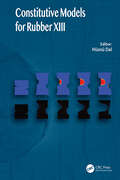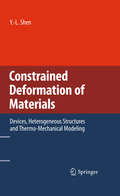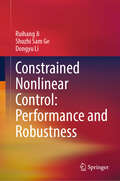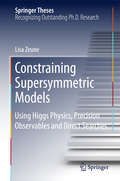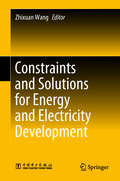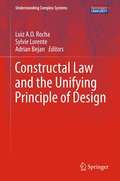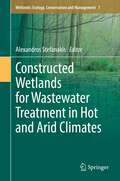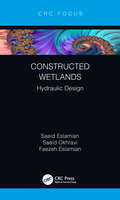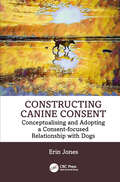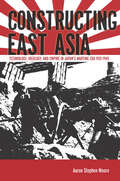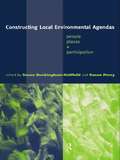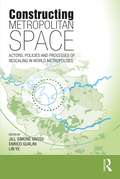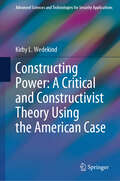- Table View
- List View
Constellations of Inequality: Space, Race, & Utopia in Brazil
by Sean T. MitchellWinner of the 2018 Latin American Studies Association (LASA) Brazil Section Book Prize In 1982, the Brazilian Air Force arrived on the Alcântara peninsula to build a state-of-the-art satellite launch facility. They displaced some 1,500 Afro-Brazilians from coastal land to inadequate inland villages, leaving many more threatened with displacement. Completed in 1990, this vast undertaking in one of Brazil’s poorest regions has provoked decades of conflict and controversy. Constellations of Inequality tells this story of technological aspiration and the stark dynamics of inequality it laid bare. Sean T. Mitchell analyzes conflicts over land, ethnoracial identity, mobilization among descendants of escaped slaves, military-civilian competition in the launch program, and international intrigue. Throughout, he illuminates Brazil’s changing politics of inequality and examines how such inequality is made, reproduced, and challenged. How people conceptualize and act on the unequal conditions in which they find themselves, he shows, is as much a cultural and historical matter as a material one. Deftly broadening our understanding of race, technology, development, and political consciousness on local, national, and global levels, Constellations of Inequality paints a portrait of contemporary Brazil that will interest a broad spectrum of readers.
Constellations: The Story of Space Told Through the 88 Known Star Patterns in the Night Sky
by Wil Tirion Govert SchillingPerfect for stargazers and armchair astronomers of all ages, CONSTELLATIONS is a beautifully illustrated, fascinatingguide to all 88 constellations, including an illustrated star map for each.In CONSTELLATIONS, award-winning astronomy writer Govert Schilling takes us on an unprecedented visual tour of all 88 constellations in our night sky. Much more than just a stargazer's guide, CONSTELLATIONS is complete history of astronomy as told by Schilling through the lens of each constellation. The book is organized alphabetically by constellation. Profiles of each constellation include basic information such as size, visibility, and number of stars, as well as information on the discovery and naming of the constellation and associated lore. Beyond details about the constellation itself is information about every astronomical event that took place or discovery made in the vicinity of the constellation. In the constellation of Cygnus (the Swan) we encounter the location of the first confirmed black hole. A stop at Gemini (the Twins) is a chance to say hello to the dwarf planet Pluto, and in Orion (the hunter) we find the location of the first identified gamma-ray burst. Stunning star maps throughout the book by acclaimed star mapmaker Wil Tirion show us the exact location of every constellation, the details of its structure, as well as its surrounding astronomical neighbors.
Constitution 3.0
by Benjamin Wittes Jeffrey RosenAt the beginning of the twenty-first century, breathtaking changes in technology are posing stark challenges to our constitutional values. From free speech to privacy, from liberty and personal autonomy to the right against self-incrimination, basic constitutional principles are under stress from technological advances unimaginable even a few decades ago, let alone during the founding era. In this provocative collection, America's leading scholars of technology, law, and ethics imagine how to translate and preserve constitutional and legal values at a time of dizzying technological change. Constitution 3.0 explores some of the most urgent constitutional questions of the near future. Will privacy become obsolete, for example, in a world where ubiquitous surveillance is becoming the norm? Imagine that Facebook and Google post live feeds from public and private surveillance cameras, allowing 24/7 tracking of any citizen in the world. How can we protect free speech now that Facebook and Google have more power than any king, president, or Supreme Court justice to decide who can speak and who can be heard? How will advanced brain-scan technology affect the constitutional right against self-incrimination? And on a more elemental level, should people have the right to manipulate their genes and design their own babies? Should we be allowed to patent new forms of life that seem virtually human? The constitutional challenges posed by technological progress are wide-ranging, with potential impacts on nearly every aspect of life in America and around the world.The authors include Jamie Boyle, Duke Law School; Eric Cohen and Robert George, Princeton University; Jack Goldsmith, Harvard Law School; Orin Kerr, George Washington University Law School; Lawrence Lessig, Harvard Law School; Stephen Morse, University of Pennsylvania Law School; John Robertson, University of Texas Law School; Christopher Slobogin, Vanderbilt Law School; O. Carter Snead, Notre Dame Law School; Jeffrey Rosen, George Washington University Law School; Benjamin Wittes, Brookings Institution; Tim Wu, Columbia Law School; and Jonathan Zittrain, Harvard Law School.
Constitution 3.0
by Benjamin Wittes Jeffrey RosenAt the beginning of the twenty-first century, breathtaking changes in technology are posing stark challenges to our constitutional values. From free speech to privacy, from liberty and personal autonomy to the right against self-incrimination, basic constitutional principles are under stress from technological advances unimaginable even a few decades ago, let alone during the founding era. In this provocative collection, America's leading scholars of technology, law, and ethics imagine how to translate and preserve constitutional and legal values at a time of dizzying technological change. Constitution 3.0 explores some of the most urgent constitutional questions of the near future. Will privacy become obsolete, for example, in a world where ubiquitous surveillance is becoming the norm? Imagine that Facebook and Google post live feeds from public and private surveillance cameras, allowing 24/7 tracking of any citizen in the world. How can we protect free speech now that Facebook and Google have more power than any king, president, or Supreme Court justice to decide who can speak and who can be heard? How will advanced brain-scan technology affect the constitutional right against self-incrimination? And on a more elemental level, should people have the right to manipulate their genes and design their own babies? Should we be allowed to patent new forms of life that seem virtually human? The constitutional challenges posed by technological progress are wide-ranging, with potential impacts on nearly every aspect of life in America and around the world.The authors include Jamie Boyle, Duke Law School; Eric Cohen and Robert George, Princeton University; Jack Goldsmith, Harvard Law School; Orin Kerr, George Washington University Law School; Lawrence Lessig, Harvard Law School; Stephen Morse, University of Pennsylvania Law School; John Robertson, University of Texas Law School; Christopher Slobogin, Vanderbilt Law School; O. Carter Snead, Notre Dame Law School; Jeffrey Rosen, George Washington University Law School; Benjamin Wittes, Brookings Institution; Tim Wu, Columbia Law School; and Jonathan Zittrain, Harvard Law School.
Constitution of Organs of the Higher Plants: The multiple secondary axis theory
by Chi YenThis book written by Professor Chi Yen of Sichuan Agricultural University in Chinese was published by China Agriculture Press (ISBN 978-7-109-22791-0). It describes a new theory on the constitution of organs of the higher plants based on experimental evidence, the multiple secondary axis theory. This theory states that all organs of the higher plants are the constitution of multiple secondary axes. The primary axis extends bipolarly to initiate the above- and the below-ground parts of a plant, from which secondary axes develop. Leaves are split, expanded upper ends of terminal secondary axes. Stems are merged lower ends of the secondary axes, Vascular bundles are secondary structures developed within the axes which interconnect with each other to form the central core of the stem and branches and the veins in the leaves. Roots form through the downward extension of the lower ends of the axes toward or within the underground and branch roots are unsplit secondary axes. All new axes emerge from the inner side of existing, split axes. All floral organs including fruits, seeds and vegetative reproduction organs such as bulbils and plantlets, are deformed axes. This theory is significant in guiding the scientific design of the ideotype of crops to optimize the development of the economically important organ(s) of a crop.
Constitutional Discussions on Nuclear Energy in Germany (Routledge Studies in Energy Policy)
by Robert RybskiThis book analyses the German constitutional system's responses towards nuclear energy.Robert Rybski begins with a presentation of energy security as a constitutional value and explores how it connects with nuclear energy. He also examines constitutional standards derived from the German Constitution, which directly regulates nuclear energy issues within the German system of power. The book presents the structure of sources of law that are binding in the area of security of nuclear installations and considers the impact that The European Atomic Energy Community had on the German constitutional system. The final part of the book is devoted to a novel judicial concept of the so-called Restrisiko – a risk that cannot be avoided – which has been developed in the jurisprudence of the Federal Constitutional Court. The essence of this concept is an assumption that as long as the legal framework regulating nuclear energy fulfils conditions formulated in that judgment, then each citizen has to accept risks resulting from the nuclear energy sector.Covering the entire period of commercial usage of nuclear energy for power generation, this book will be of great interest to students, scholars and energy experts who are active in researching or adopting public policies related to the nuclear energy sector.
Constitutional Dynamic Chemistry (Topics in Current Chemistry #322)
by Mihail BarboiuConstitutional Dynamic Chemistry: Bridge from Supramolecular Chemistry to Adaptive Chemistry, by Jean-Marie Lehn Multistate and Phase Change Selection in Constitutional Multivalent Systems, by Mihail Barboiu Dynamic Systemic Resolution, by Morakot Sakulsombat, Yan Zhang and Olof Ramström Dynamic Combinatorial Self-Replicating Systems, by Emilie Moulin and Nicolas Giuseppone DCC in the Development of Nucleic Acid Targeted and Nucleic Acid Inspired Structures, by Benjamin L. Miller Dynamic Nanoplatforms in Biosensor and Membrane Constitutional Systems, by Eugene Mahon, Teodor Aastrup und Mihail Barboiu Dynamic Assembly of Block-Copolymers, by D. Quémener, A. Deratani und S. Lecommandoux Dynamic Chemistry of Anion Recognition, by Radu Custelcean Supramolecular Naphthalenediimide Nanotubes, by Nandhini Ponnuswamy, Artur R. Stefankiewicz, Jeremy K. M. Sanders und G. Dan Pantoş Synthetic Molecular Machines and Polymer/Monomer Size Switches that Operate Through Dynamic and Non-Dynamic Covalent Changes, by Adrian-Mihail Stadler und Juan Ramírez Reversible Covalent Chemistries Compatible with the Principles of Constitutional Dynamic Chemistry: New Reactions to Create More Diversity, by Kamel Meguellati und Sylvain Ladame.
Constitutive Modelling of Solid Continua (Solid Mechanics and Its Applications #262)
by José Merodio Raymond OgdenThis volume consists of a collection of chapters by recognized experts to provide a comprehensive fundamental theoretical continuum treatment of constitutive laws used for modelling the mechanical and coupled-field properties of various types of solid materials. It covers the main types of solid material behaviour, including isotropic and anisotropic nonlinear elasticity, implicit theories, viscoelasticity, plasticity, electro- and magneto-mechanical interactions, growth, damage, thermomechanics, poroelasticity, composites and homogenization. The volume provides a general framework for research in a wide range of applications involving the deformation of solid materials. It will be of considerable benefit to both established and early career researchers concerned with fundamental theory in solid mechanics and its applications by collecting diverse material in a single volume. The readership ranges from beginning graduate students to senior researchers in academia and industry.
Constitutive Models for Rubber IX
by Bohdana Marvalová Iva PetríkováThe unique properties of rubber make it ideal for use in a wide variety of engineering applications such as tyres, engine mounts, shock absorbers, flexible joints and seals. Developing diverse elastomeric elements for various structures involves numerical simulations of their performance, which are based on reliable constitutive models of the mater
Constitutive Models for Rubber VIII
by Nere Gil-Negrete Asier AlonsoDue to their unique properties, rubber materials are found in multiple engineering applications such as tires, engine mounts, shock absorbers, flexible joints, seals, etc. Nevertheless, the complex nature of the behavior of such material makes it difficult to accurately model and predict the performance of these units.The challenge to correctly rep
Constitutive Models for Rubber X: Proceedings of the European Conference on Constitutive Models for Rubbers X (Munich, Germany, 28-31 August 2017)
by Alexander Lion Michael JohlitzIn order to develop innovative products, to reduce development costs and the number of prototypes and to accelerate development processes, numerical simulations become more and more attractive. As such, numerical simulations are instrumental in understanding complicated material properties like chemical ageing, crack propagation or the strain- and temperature-induced crystallisation of rubber. Therefore, experimentally validated and physically meaningful constitutive models are indispensable. Elastomers are used for products like tyres, engine and suspension mounts or seals, to name a few. The interest in modelling the quasi-static stress-strain behaviour was dominant in the past decades, but nowadays the interests also include influences of environmental conditions. The latest developments on the material behaviour of elastomers are collected in the present volume. Constitutive Models for Rubber X is a comprehensive compilation of nearly all oral and poster contributions to the European Conference on Constitutive Models for Rubber (Munich, 28-31 August 2017). The 95 highly topical contributions reflect the state of-the-art in material modelling and testing of elastomers. They cover the fields of material testing and processing, filler reinforcement, electromagnetic sensitive elastomers, dynamic properties, constitutive modelling, micromechanics, finite element implementation, stress softening, chemical ageing, fatigue and durability. In the area of rubbery materials and structures, applied research will play an important role also in the coming decades. Constitutive Models for Rubber X is of interest to developers and researchers involved in the rubber processing and CAE software industries, as well as for academics in nearly all disciplines of engineering and material sciences.
Constitutive Models for Rubbers XIII
by Hüsnü DalConstitutive Models for Rubber XIII is a comprehensive compilation of the oral and poster contributions to the XIII European Conference on Constitutive Models for Rubbers (İstanbul, Türkiye, 26-28 June 2024). The XIII edition again brought together researchers from the industry and the academia working in the field of elastomer technology and science to discuss the most recent advancement in the following topics:• Constitutive models• Micro-structural investigations• Experimental methods and characterization• Numerical methods• Fatigue and fracture• Aging• Industrial applications• Smart elastomer materials: applications and modelling• Recyclable elastomer systems design and modellingIncluding 53 contributions from authors from around the world, this book aims at professionals and academics interested in recent advances in elastomer technology and science.
Constrained Deformation of Materials: Devices, Heterogeneous Structures and Thermo-Mechanical Modeling
by Y. L. Shen"Constrained Deformation of Materials: Devices, Heterogeneous Structures and Thermo-Mechanical Modeling" is an in-depth look at the mechanical analyses and modeling of advanced small-scale structures and heterogeneous material systems. Mechanical deformations in thin films and miniaturized materials, commonly found in microelectronic devices and packages, MEMS, nanostructures and composite and multi-phase materials, are heavily influenced by the external or internal physical confinement. A continuum mechanics-based approach is used, together with discussions on micro-mechanisms, to treat the subject in a systematic manner under the unified theme. Readers will find valuable information on the proper application of thermo-mechanics in numerical modeling as well as in the interpretation and prediction of physical material behavior, along with many case studies. Additionally, particular attention is paid to practical engineering relevance. Thus real-life reliability issues are discussed in detail to serve the needs of researchers and engineers alike.
Constrained Nonlinear Control: Performance and Robustness
by Shuzhi Sam Ge Dongyu Li Ruihang JiThis book is concerned with nonlinear control with performance-related and system-ability-related constraints. It presents novel work on several kinds of commonly encountered nonlinear systems, including those with stricter transient performance requirements, those with two types of constraints, those with no initial-condition limitation, and those with limited resources. It shows how nonlinear systems with severe constraints can be successfully controlled with our powerful control design. Typically, the book discusses a Tunnel Prescribed Control for achieving enhanced performance; provides a comprehensive solution, namely, Saturation-tolerant Prescribed Control, to handle the conflict between constraints; and then develops a Self-adjustable Prescribed Control to address the defined Entry Capture Problem that performance constraints are satisfied after (rather than from the beginning of) system operation. As such, the book will be of interest to researchers and graduate students in the fields of nonlinear systems, constrained control, and control engineering who would like to find out about the performance, robustness, and applications of constrained nonlinear systems.
Constraining Supersymmetric Models: Using Higgs Physics, Precision Observables and Direct Searches (Springer Theses)
by Lisa ZeuneThis thesis analyses how supersymmetric (SUSY) extensions of the Standard Model (SM) of particle physics can be constrained using information from Higgs physics, electroweak precision observables and direct searches for new particles. Direct searches for SUSY particles at the LHC have not resulted in any signal so far, and limits on the SUSY parameter space have been set. Measurements of the properties of the observed Higgs boson at 125 GeV as well as of the W boson mass can provide valuable indirect constraints, supplementing the ones from direct searches. Precise calculations are performed for Higgs decays and electroweak precision observables within the minimal supersymmetric extension of the Standard Model and the next to-minimal supersymmetric extension of the Standard Model. Furthermore, a method is presented to reinterpret the LHC limits from direct SUSY searches in more realistic SUSY scenarios. The phenomenological consequences of those results are thoroughly analysed.
Constraints and Solutions for Energy and Electricity Development
by Zhixuan WangThis book primarily focuses on constraints and solutions for energy and electric power development. On the basis of analyses, proposes a planning index system including 26 binding indicators and the breaking constraints measures. Offering significant insights and proposals concerning the current status of energy development and the key limiting factors to sustainable energy development in China, it is a valuable resource for policy-makers, managers and researchers in the energy sector.
Constructal Law and the Unifying Principle of Design (Understanding Complex Systems)
by Adrian Bejan Sylvie Lorente Luiz A.O. RochaDesign happens everywhere, whether in animate objects (e.g., dendritic lung structures, bacterial colonies, and corals), inanimate patterns (river basins, beach slope, and dendritic crystals), social dynamics (pedestrian traffic flows), or engineered systems (heat dissipation in electronic circuitry). This "design in nature" often takes on remarkably similar patterns, which can be explained under one unifying Constructal Law. This book explores the unifying power of the Constructal Law and its applications in all domains of design generation and evolution, ranging from biology and geophysics to globalization, energy, sustainability, and security. The Constructal Law accounts for the universal tendency of flow systems to morph into evolving configurations that provide greater and easier access over time. The Constructal Law resolves the many and contradictory ad hoc statements of "optimality", end design, and destiny in nature, such as minimum and maximum entropy production and minimum and maximum flow resistance, and also explains the designs that are observed and copied in biomimetics. Constructal Law and the Unifying Principle of Design covers the fundamentals of Constructal Theory and Design, as well as presenting a variety of state-of-the-art applications. Experts from the biological, physical and social sciences demonstrate the unification of all design phenomena in nature, and apply this knowledge to novel designs in modern engineering, such as vascularization for self-healing and self-cooling materials for aircraft, and tree fins and cavities for heat transfer enhancement.
Constructed Wetlands for Wastewater Treatment in Hot and Arid Climates (Wetlands: Ecology, Conservation and Management #7)
by Alexandros StefanakisThis edited book presents the first collection of case studies and research projects on the sustainable technology of constructed wetlands for wastewater management under hot and arid climates. It is the first such work that summarizes in a single reference the current international experiences and knowledge on the implementation of this nature-based solution under these diverse and often harsh climatic conditions. It covers the relevant gap in the fragmented and limited literature by providing integrated information and documentation on the feasibility of this green technology.The book presents the treatment efficiency of constructed wetland facilities and the research output from 29 different countries across South America, Africa, Asia and Oceania, while it covers various applications such as domestic and municipal wastewater, various industrial effluents and municipal sludge. Many examples and case studies further demonstrate the potential of this technology to contribute to better address the issues of water scarcity and limited fresh water resources through circular management of treated effluents e.g. reuse in irrigation. It also discusses the various challenges and technical aspects that should be considered in such climates, along with the environmental, financial and social benefits of this technology.This work is a useful handbook and guide for professional engineers, practitioners, academics, researchers, students, and water authorities who wish to get a better understanding and first-hand information on the potential of constructed wetlands for cost-effective and sustainable wastewater management in countries with hot and arid climates.
Constructed Wetlands: Hydraulic Design
by Saeid Eslamian Saeid Okhravi Faezeh EslamianConstructed Wetlands: Hydraulic Design provides fundamental information on internal wetland hydraulic and biochemical processes, as well as practical guidance on the effective design of wetlands for water treatment. It includes the latest innovations and technological advances of constructed wetlands based on the newest technologies in the field. <p><p>Features: <li>Explains how various pollutants are either retained or removed from treatment systems <li>Examines system geometry, flow rate, inlet-outlet configurations, and more <li>Offers useful guidance and tools to practitioners for designing wastewater treatment structures naturally and optimally <li>Introduces the various aspects of hydraulic engineering through porous media <p><p>This book will serve as a valuable resource for practicing professionals, researchers, policy makers, and students seeking to gain an in-depth understanding of the hydraulic processes involved in constructed wetlands water treatment systems.
Constructing Canine Consent: Conceptualising and adopting a consent-focused relationship with dogs
by Erin JonesThe concept of canine consent is far more than simply a buzzword in modern dog training practices. In its current form, consent is a distinctly human concept, designed by humans and for humans. Looking beyond species boundaries can help us not only consider concepts of canine consent and autonomy, but it can also help us to apply these concepts in our everyday interactions with dogs, which is fundamental for any professional working with dogs as well as for everyday dog caregivers. This canine-indexed definition of consent includes a model of five major categories: Touch/interaction-based consent, cooperative care using learned consent behaviours, activity consent, consent-based learning, and substitutive consent. These categories involve a two-way communication system, integration of salient choices, teaching consent behaviours and incorporating existing training protocols that adhere to the Humane Hierarchy of best practices, and an evaluation of dependent decision-making in extenuating circumstances. This book aims to merge the existing literature and new understandings about canine consent to paint a complete picture. It will challenge the current expectations of dogs and dog behaviour in our society with an intention of considering their perspectives, experiences, and emotional needs. It will be important reading for veterinary professionals, dog trainers and behaviourists, those involved in work with therapy dogs, and anybody working with or caring for dogs.
Constructing East Asia: Technology, Ideology, and Empire in Japan's Wartime Era, 1931-1945
by Aaron Stephen MooreThe conventional understanding of Japanese wartime ideology has for years been summed up by just a few words: anti-modern, spiritualist, and irrational. Yet such a cut and dried picture is not at all reflective of the principles that guided national policy from 1931–1945. Challenging the status quo, Constructing East Asia examines how Japanese intellectuals, bureaucrats, and engineers used technology as a system of power and mobilization—what historian Aaron Moore terms a "technological imaginary"—to rally people in Japan and its expanding empire. By analyzing how these different actors defined technology in public discourse, national policies, and large-scale infrastructure projects, Moore reveals wartime elites as far more calculated in thought and action than previous scholarship allows. Moreover, Moore positions the wartime origins of technology deployment as an essential part of the country's national policy and identity, upending another predominant narrative—namely, that technology did not play a modernizing role in Japan until the "economic miracle" of the postwar years.
Constructing Local Environmental Agendas: People, Places and Participation
by Susan Percy Susan Buckingham-HatfieldConstructing Local Environmental Agendas draws on original contributions from specialists worldwide to argue that there is scope for local areas to improve their environments, provided local people are involved. International case studies, from UK, Europe, Australia, Pakistan and Sri Lanka, demonstrate the importance of respect for indigenous knowledge and the need to remove layers of bureaucracy from policy making.
Constructing Metropolitan Space: Actors, Policies and Processes of Rescaling in World Metropolises
by Lin Ye Jill Simone Gross Enrico GualiniThere is little question today that processes of globalization affect national and local economies, governance processes, and conditions for economic competitiveness in the major urban regions of the world. In most liberal-democratic countries, these processes are occurring according to a rationale which attempts to combine strategies of state-supported development with increasing local-regional governmental decentralization and autonomy. Against this background, the issue of metropolitan development is being redefined worldwide, along with its institutional frameworks, modes of governance, policy instruments, and spatial planning strategies. The overarching assumption of this volume is that ‘metropolitan space’, far from being consolidated as a policy object, is currently being redefined and in some instances ‘constructed’ and contested as a scale, through a variety of policy practices related to spatial-economic development objectives. Through case studies drawn from across four continents, the authors reveal a range of interesting cross-national commonalities concerning the power that state actors, situated at various spatial scales, exert as agents in these processes. This volume interrogates key research issues raised by these developments, and is intended as a contribution to the establishment of a globally comparative analysis of the construction of metropolitan spaces and scales under conditions of globalization and neoliberalization.
Constructing Power: A Critical and Constructivist Theory Using the American Case (Advanced Sciences and Technologies for Security Applications)
by Kirby L. WedekindThis book asserts that there exists a causal relationship between identity, interest, and the exercise of power. The work defines power as the ability to satisfy oneself, which makes power contingent upon belief. It also dissects the concepts of identity, interest, and power to reveal how each works and relate to the others. This analysis creates a new theory of power using constructivism informed by critical theory, departing from neorealist and neoliberal perspectives. The work uses the United States to test the theory by examining US national identity, interest, and exercises of power. A deconstruction of American Exceptionalism proceeds three case studies and runs as a theme to connect each, unifying the work. A military operation in 2016 against the Islamic State in Libya, the 2014 Russian annexation of Crimea, and the whiplash caused by US participation in the 2015 Paris Agreement serve as the three case studies for analyzing US identity, interest, and power through the theory. This work proposes a new way of understanding power based on constructivism and informed by critical theory that applies to interpersonal and international relationships. Every relation is a power relation and power is the ability to satisfy oneself. This book provides insight into the underlying causes and machinations that transpire within every kind of social relation. This is a significant shift in how power is understood and applied in politics, the military, business, and interpersonal relationships. This book seeks to provide the reader with greater and clearer understanding of themselves, the world in which they live, and why it exists as such.
Constructing Reality
by John Marburger IIIQuestions of the fundamental nature of matter continue to inspire and engage our imagination. However, the exciting new concepts of strings, supersymmetry and exotic matter build on ideas that are well known to physicists but mysterious and puzzling to people outside of these research fields. Covering key conceptual developments from the last century, this book provides a background to the bold ideas and challenges faced by physicists today. Quantum theory and the Standard Model of particles are explained with minimal mathematics, and advanced topics, such as gauge theory and quantum field theory, are put into context. With concise, lucid explanations, this book is an essential guide to the world of particle physics.
